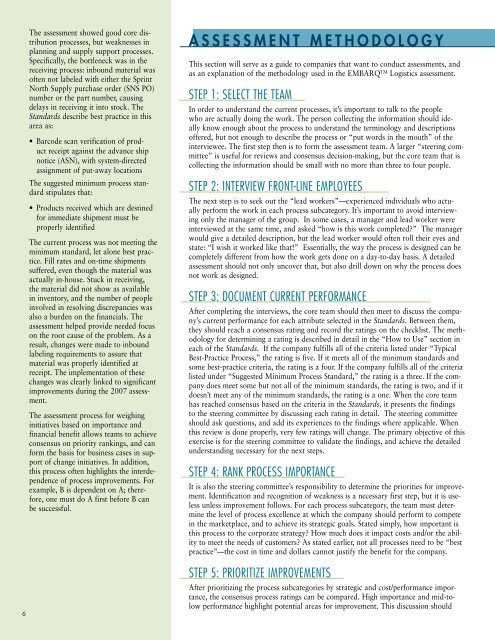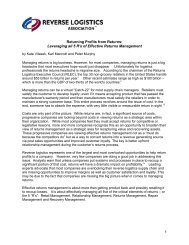PROCESS ASSESSMENT IN THE SUPPLY CHAIN: the eMBARQtM ...
PROCESS ASSESSMENT IN THE SUPPLY CHAIN: the eMBARQtM ...
PROCESS ASSESSMENT IN THE SUPPLY CHAIN: the eMBARQtM ...
You also want an ePaper? Increase the reach of your titles
YUMPU automatically turns print PDFs into web optimized ePapers that Google loves.
6<br />
The assessment showed good core distribution<br />
processes, but weaknesses in<br />
planning and supply support processes.<br />
Specifically, <strong>the</strong> bottleneck was in <strong>the</strong><br />
receiving process: inbound material was<br />
often not labeled with ei<strong>the</strong>r <strong>the</strong> Sprint<br />
North Supply purchase order (SNS PO)<br />
number or <strong>the</strong> part number, causing<br />
delays in receiving it into stock. The<br />
Standards describe best practice in this<br />
area as:<br />
• Barcode scan verification of product<br />
receipt against <strong>the</strong> advance ship<br />
notice (ASN), with system-directed<br />
assignment of put-away locations<br />
The suggested minimum process standard<br />
stipulates that:<br />
• Products received which are destined<br />
for immediate shipment must be<br />
properly identified<br />
The current process was not meeting <strong>the</strong><br />
minimum standard, let alone best practice.<br />
Fill rates and on-time shipments<br />
suffered, even though <strong>the</strong> material was<br />
actually in-house. Stuck in receiving,<br />
<strong>the</strong> material did not show as available<br />
in inventory, and <strong>the</strong> number of people<br />
involved in resolving discrepancies was<br />
also a burden on <strong>the</strong> financials. The<br />
assessment helped provide needed focus<br />
on <strong>the</strong> root cause of <strong>the</strong> problem. As a<br />
result, changes were made to inbound<br />
labeling requirements to assure that<br />
material was properly identified at<br />
receipt. The implementation of <strong>the</strong>se<br />
changes was clearly linked to significant<br />
improvements during <strong>the</strong> 2007 assessment.<br />
The assessment process for weighing<br />
initiatives based on importance and<br />
financial benefit allows teams to achieve<br />
consensus on priority rankings, and can<br />
form <strong>the</strong> basis for business cases in support<br />
of change initiatives. In addition,<br />
this process often highlights <strong>the</strong> interdependence<br />
of process improvements. For<br />
example, B is dependent on A; <strong>the</strong>refore,<br />
one must do A first before B can<br />
be successful.<br />
A s s e s s m e n t m e t h o D o l o g y<br />
This section will serve as a guide to companies that want to conduct assessments, and<br />
as an explanation of <strong>the</strong> methodology used in <strong>the</strong> EMBARQ TM Logistics assessment.<br />
SteP 1: SeleCt <strong>the</strong> teaM<br />
In order to understand <strong>the</strong> current processes, it’s important to talk to <strong>the</strong> people<br />
who are actually doing <strong>the</strong> work. The person collecting <strong>the</strong> information should ideally<br />
know enough about <strong>the</strong> process to understand <strong>the</strong> terminology and descriptions<br />
offered, but not enough to describe <strong>the</strong> process or “put words in <strong>the</strong> mouth” of <strong>the</strong><br />
interviewee. The first step <strong>the</strong>n is to form <strong>the</strong> assessment team. A larger “steering committee”<br />
is useful for reviews and consensus decision-making, but <strong>the</strong> core team that is<br />
collecting <strong>the</strong> information should be small with no more than three to four people.<br />
SteP 2: IntervIew Front-lIne eMPloyeeS<br />
The next step is to seek out <strong>the</strong> “lead workers”—experienced individuals who actually<br />
perform <strong>the</strong> work in each process subcategory. It’s important to avoid interviewing<br />
only <strong>the</strong> manager of <strong>the</strong> group. In some cases, a manager and lead worker were<br />
interviewed at <strong>the</strong> same time, and asked “how is this work completed?” The manager<br />
would give a detailed description, but <strong>the</strong> lead worker would often roll <strong>the</strong>ir eyes and<br />
state: “I wish it worked like that!” Essentially, <strong>the</strong> way <strong>the</strong> process is designed can be<br />
completely different from how <strong>the</strong> work gets done on a day-to-day basis. A detailed<br />
assessment should not only uncover that, but also drill down on why <strong>the</strong> process does<br />
not work as designed.<br />
SteP 3: DoCuMent Current PerForManCe<br />
After completing <strong>the</strong> interviews, <strong>the</strong> core team should <strong>the</strong>n meet to discuss <strong>the</strong> company’s<br />
current performance for each attribute selected in <strong>the</strong> Standards. Between <strong>the</strong>m,<br />
<strong>the</strong>y should reach a consensus rating and record <strong>the</strong> ratings on <strong>the</strong> checklist. The methodology<br />
for determining a rating is described in detail in <strong>the</strong> “How to Use” section in<br />
each of <strong>the</strong> Standards. If <strong>the</strong> company fulfills all of <strong>the</strong> criteria listed under “Typical<br />
Best-Practice Process,” <strong>the</strong> rating is five. If it meets all of <strong>the</strong> minimum standards and<br />
some best-practice criteria, <strong>the</strong> rating is a four. If <strong>the</strong> company fulfills all of <strong>the</strong> criteria<br />
listed under “Suggested Minimum Process Standard,” <strong>the</strong> rating is a three. If <strong>the</strong> company<br />
does meet some but not all of <strong>the</strong> minimum standards, <strong>the</strong> rating is two, and if it<br />
doesn’t meet any of <strong>the</strong> minimum standards, <strong>the</strong> rating is a one. When <strong>the</strong> core team<br />
has reached consensus based on <strong>the</strong> criteria in <strong>the</strong> Standards, it presents <strong>the</strong> findings<br />
to <strong>the</strong> steering committee by discussing each rating in detail. The steering committee<br />
should ask questions, and add its experiences to <strong>the</strong> findings where applicable. When<br />
this review is done properly, very few ratings will change. The primary objective of this<br />
exercise is for <strong>the</strong> steering committee to validate <strong>the</strong> findings, and achieve <strong>the</strong> detailed<br />
understanding necessary for <strong>the</strong> next steps.<br />
SteP 4: rank ProCeSS IMPortanCe<br />
It is also <strong>the</strong> steering committee’s responsibility to determine <strong>the</strong> priorities for improvement.<br />
Identification and recognition of weakness is a necessary first step, but it is useless<br />
unless improvement follows. For each process subcategory, <strong>the</strong> team must determine<br />
<strong>the</strong> level of process excellence at which <strong>the</strong> company should perform to compete<br />
in <strong>the</strong> marketplace, and to achieve its strategic goals. Stated simply, how important is<br />
this process to <strong>the</strong> corporate strategy? How much does it impact costs and/or <strong>the</strong> ability<br />
to meet <strong>the</strong> needs of customers? As stated earlier, not all processes need to be “best<br />
practice”—<strong>the</strong> cost in time and dollars cannot justify <strong>the</strong> benefit for <strong>the</strong> company.<br />
SteP 5: PrIorItIze IMProveMentS<br />
After prioritizing <strong>the</strong> process subcategories by strategic and cost/performance importance,<br />
<strong>the</strong> consensus process ratings can be compared. High importance and mid-tolow<br />
performance highlight potential areas for improvement. This discussion should




